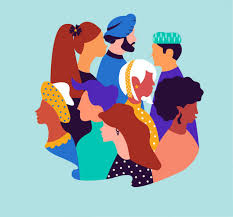
A cultural norm refers to an acceptable conduct in society.
A cultural norm serves as a guideline for behavior, dress, language, and demeanor in a situation, which serves as a template for expectations in a social group.
Cultures are internally affected by both forces encouraging change and forces resisting change.
Cultures are externally affected via contact between societies.
Culture encompassesv a range of phenomena that are transmitted through social learning in human societies.
Cultural universals are found in all human societies and include expressive forms like art, music, dance, ritual, religion, and technologies like tool usage, cooking, shelter, and clothing.
The concept of material culture covers the physical expressions of technology, architecture and art, whereas the immaterial aspects of culture such as principles of social organization include practices of political organization and social institutions, mythology, philosophy, literature and science comprise the intangible cultural heritage of a society.
In the humanities, culture contributes attribute to a particular level of sophistication in the arts, sciences, education, or manners.
Cultural sophistication has also sometimes been used to distinguish civilizations from less complex societies.
Culture also has class-based distinctions between a high culture of the social elite and a low culture, popular culture, or folk culture of the lower classes, distinguished by the stratified access to cultural capital.
Culture is often used to refer specifically to the symbolic markers used by ethnic groups to distinguish themselves visibly from each other such as body modification, clothing or jewelry.
Mass culture refers to the mass-produced and mass-mediated forms of consumer culture.
Human symbolic culture arises from the material conditions of human life, as humans create the conditions for physical survival, and that the basis of culture is found in evolved biological dispositions.
Culture is the set of customs, traditions, and values of a society or community, such as an ethnic group or nation.
Culture is the set of knowledge acquired over time.
Multiculturalism values the peaceful coexistence and mutual respect between different cultures inhabiting the same planet.
Sometimes culture is also used to describe specific practices within a subgroup of a society, a subculture or a counterculture.
Culture is the way of life, especially the general customs and beliefs, of a particular group of people at a particular time.
Cultural changes can be brought achieved by,including growth, development, evolution, involution, renovation, reconception, reform, innovation, revivalism, revolution, mutation, progress, diffusion, osmosis, borrowing, eclecticism, syncretism, modernization, indigenization, and transformation.
Accelerating culture changes are driven by the expansion of international commerce, the mass media, and the human population explosion.
Cultures are affected by both forces encouraging change and forces resisting change.
These forces are related to both social structures and natural events perpetuating cultural ideas and practices within current structures, which themselves are subject to change.
Social conflict and the development of technologies can produce changes within a society by altering social dynamics and promoting new cultural models.
Social shifts may accompany ideological shifts and other types of cultural change.
The feminist movement involved new practices that produced a shift in gender relations, altering both gender and economic structures.
Environmental conditions alter culture: after tropical forests returned at the end of the last ice age, plants suitable for domestication were available, leading to the invention of agriculture, which in turn brought about many cultural innovations and shifts in social dynamics.
War or competition over resources may impact technological development or social dynamics and culture.
Cultural ideas may transfer from one society to another, through diffusion or acculturation.
Acculturation refers to the replacement of traits of one culture with another.
In practice, culture referred to an elite ideal and was associated with such activities as art, classical music, and haute cuisine.
Culture can be non-material culture or material culture.
Non-material culture refers to the non-physical ideas that individuals have about their culture, including values, belief systems, rules, norms, morals, language, organizations, and institutions.
Material culture is the physical evidence of a culture in the objects and architecture they make or have made.
Cultural studies is concerned with the meaning and practices of everyday life; the ways people do particular things such as watching television or eating out in a given culture.
Cultural studies also study the meanings and uses people attribute to various objects and practices.
Culture involves those meanings and practices held independently of reason.
Culture may affect the way that people experience and express emotions:Westerners are more motivated by their successes than their failures, while East Asians are better motivated by the avoidance of failure.
American-style teen turmoil is absent in more than 100 cultures around the world, suggesting that such mayhem is not biologically inevitable.
